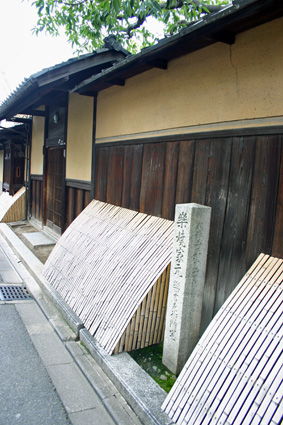| The Raku museum- a precious gem in the heart of Kyoto |
||||
 |
Entering the Raku
museum, nestled in the backstreets of Kyoto's historical imperial palace
district,is like visiting the home of a welcoming relative. We were met
at the door and shown where to store our baggage and shoes, before being
ushered inside past a seasonal flower arrangement (regularly watered to
keep shiny droplets on the petals and leaves!) into a light and airy reception
area. The attentive staff then gave us a brief introduction to the history of Raku, pausing midway to alert us to the sound of birdsong in the garden, before directing us upstairs to the main body of the exhibiton. The Raku museum is situated next door to the Raku family workshop. Piles of stones from the Kamogame river, which are pounded to provide the powder for the glaze, could be seen in the garden. The exhibition changes periodically and on the day we visited featured mainly "kougou", incense boxes used in the tea ceremony, on the theme of the Chinese Zodiac. It was fascinating to compare the pieces made by the different generations of Raku craftsmen and to find recurring patterns and styles.(However,personally we would have been even happier had there been more matcha chawan on show, because we had heard that we could actually hold some of them in our hands). |
|||
| After a pleasant 30 minutes of looking around the upstairs floors, we made
our way out exchanging greetings with the friendly curator, who having
sensed our interest in the production process showed us photographs and
diagrams of the kilns. Kilns for black raku and red raku are separate.
Both are charcoal fired, with the black raku fired in a small chamber,
piece by piece. The kiln for red raku is slightly larger, accomodating
two or three pieces. The firing of the kilns is a big event, involving
not only the craftsmen but also an army of volunteers from the neighbourhood.
Veterans with many years of working the bellows bring their sons who in
turn will pass the custom on to future generations. Each person has his
own particular style and pace and the craftsman will choose who he wants
to help with firing according to the character of the piece. Imagine the
pressure if chosen to fire a Raku masterpiece! In addition we were told
that any piece which does not live up to expectations is promptly smashed!
We had always considered it awe-inspiring that such a small family run kiln could have ruled the tea ceremony world for so long. However we came away from the Raku museum with the realization that that as well as the superb artistry of its craftsmen, the obvious love and respect of its workers and its deep ties to the local community have also played a large part. The Raku museum offers a wonderful insight into the history and traditions of Raku ware and all in a calm and serene setting which could only be found in Kyoto. |
 Entrance of the workshop The workshop is not open to the public. Unfortunately we cannot show photos of the interior of the museum as photography is not permitted. |
|||